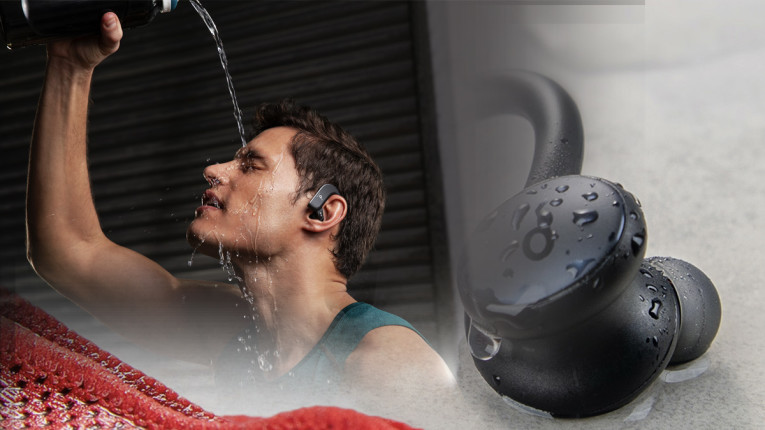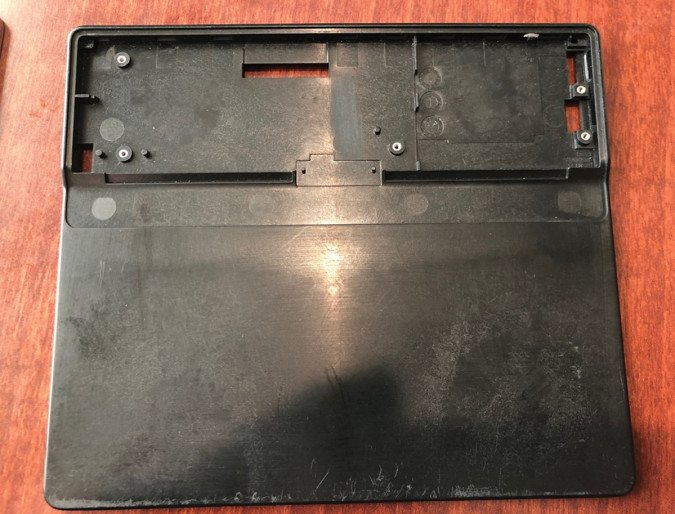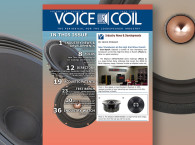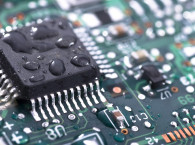
For sound quality, the prize goes to surface hard-coats and I have watched this process mature over the last half century. Back in the 1970s, the Japanese speaker engineers at Matsushita, Pioneer, Yamaha, and others looked at high stiffness materials and began work with Beryllium and Boron.
There were interesting papers, and even limited-edition products produced. Yamaha had chemical vapor deposition (CVD) beryllium midrange and dome tweeters in its high-end products, so did Pioneer along with its TAD super-premium transducers. Boron, an esoteric non-metal element, was used by Pioneer and Matsushita (Panasonic Technics) for dome tweeters (and is still popular in audiophile phono cartridge cantilevers). The short version of the vapor deposition process was to use a dome tool on which particles were vapor deposited forming the part and then removed (or melted) from the form leaving the “egg shell.”
These tweeter or compression driver domes were extremely vulnerable to cracking and shattering during assembly handling. But the reality is that the process essentially formed a part that while stiff, was brittle and did not like to be mechanically shocked—not a good attribute for a vibrating speaker membrane! While boron can be a consumed supplement in small doses, in some forms it is toxic. Aside from boron, beryllium can result in a chronic beryllium disease (CBD), which is the scarring of lung tissue that may occur when beryllium is inhaled as dust or fumes (and can occur during grinding, soldering or otherwise heating).
Thankfully, times have changed. Back then cigarette smoking, even on planes, was common; cars belched leaded gas fumes, and asbestos was considered an awesome high temperature insulator (and voice coil collar material). That stuff is all long gone and so are the boron and CVD beryllium diaphragms. Yes, foil beryllium diaphragms are still with us and are reasonably safe, but there are REACH (which stands for Registration, Evaluation, Authorization, and Restriction of Chemicals) regulations for end-of-life disposal. No one wants to die for a couple of decibels up at 30kHz.
Synthetic Diamonds and DLC
In more recent years, there has been the development of synthetic diamonds along with a diamond-like-coating (DLC). This process enables depositing the diamond film on a form and afterward removing the pure diamond part off the tool. The beneficial properties of DLC film are its ability to change the sound velocity in the diaphragm. Just as with domes made of beryllium and boron, DLC domes have high stiffness but without toxicity issues. Increasing the stiffness causes the break-up frequency of the membrane to shift upward and increases the bandwidth of the loudspeaker while damping membrane resonances.
Today there are self-supporting DLC diamond dome tweeters from Accuton (which sources its domes from Diamond Materials GmbH, a spin-off from the Fraunhofer Institute); SEAS, which has its EXEL diamond tweeters; and Bowers & Wilkins’ diamond tweeters with domes from Element 6 group of De Beers (which has a diamond monopoly). Self-supporting/no substrate diamond diaphragms are brittle and extremely fragile until final assembly. Even when assembled into a finished tweeter, the dome may sag or even collapse, and it takes little effort to shatter the dome.
For a robust tweeter, headphone, earphone, or compression driver diaphragm that is best able to face the acoustic world, they should have a thin-film coating on a substrate. But that is easier said than done as most CVD processes use microwave or convention heating at about 200°C for a few seconds. While carbon fiber is unfazed by 200°C, most binders are excessively degraded. Polymer films, such as PEEK and PEN, also lose integrity but the few parts that make it through are awesome and are limited edition successes.
There is now a state-of-the-art REACH-compliant CVD process that is well under 100°C from Oerlikon Surface Solutions (www.oerlikon.com). Specializing in high-tech solutions designed for applications in growth markets, such as speakers, automotive, aerospace, energy, the tooling industry, and additive manufacturing. Applied by PVD or Plasma Assisted Chemical Vapor Deposition (PACVD), a vacuum-based process used to deposit DLC coatings, also known as Amorphous Diamond-Like Carbon (ADLC). These very hard thin coatings increase the Young’s modules and stiffness of compression driver and tweeter domes and cones. It is applicable on multiple substrates, such as aluminum, titanium, PEEK, and composites thanks to the very low temperature (60°C) of the process and it does not add weight due to the very low thickness 1µm to 2 µm.
Structural Plating Plastic Components
There are many cases where plastics are an appealing choice because of their light weight and low cost, but plastic can cheapen the appearance or even compromise the integrity of the product. This is especially the case when the part (e.g., a headphone yoke or hinge) connects to the internal frame structure (e.g., a tablet or laptop). Retooling for a metal casting or thickening the frame is not going to be a popular option for already tooled but flexing components and no manufacturer wants to experience failures from the field. If the marginal plastic part could just get a magic coating that greatly increases are tensile strength, stiffness, and tenacity that might save the day.
Now Integran (www.integran.com) has introduced Nanovate, a metallurgical nano-technology that delivers this solution and is based on electrodeposited nano crystalline “Nanovate” structural metal coatings. While Integran and its predecessor organizations have been in metallurgical nano-technology development for more than 20 years, this is finally a commercially viable option for a wide range of audio applications.
Other applications where both the strength and stiffness are required, but a finished appearance is needed include speaker mounting brackets, subwoofer cones, and headphone components. For reference, industrial applications utilizing Nanovate normally replace CNC aluminum or injected magnesium with an equally strong and lower-cost solution that is also corrosion and wear resistant. Other attributes include shielding against low-frequency magnetic interference and higher energy and noise absorption.
For PCB manufacturing, Nanovate Foils stencil foils combine the speed and cost savings of laser cutting with the durability and performance of electroformed nickel stencils. Specifically, Nanovate Foils offer two times the improvement in stencil life compared to stainless steel with precise thickness tolerance, flatness, and mirror surface finish.

Antiviral/Antimicrobial Coatings
Integran has recently developed a line of Fluorocarbon-free and low-VOC antiviral/microbial (AVM) polymer coatings for diverse applications utilizing Environmental Protection Agency (EPA)-registered antimicrobial additives. The AVM coatings rapidly and continuously kill pathogens on contact with a simple spray and room temperature curing process, reducing the spread of viruses, bacteria, and fungi by fomite transmission. Also a reduction in the time and effort needed to clean, sanitize and disinfect surface as well as the amount of cleaning, sanitizing and disinfecting products that are needed with a patented and proprietary hydrophobic/easy-clean polymer technologies.
Another anti-microbial coating is from Kastus Technologies (www.kastus.com). This particular coating is used for Touch Glass Devices commonly used in Custom Install, Automotive, and Pro Audio segments. It offers a permanent antimicrobial coating for glass so in the audio world this would be an excellent solution for cover glass found in user interfaces in products with touch control interfaces, such as hospitality, aircraft in-flight-entertainment (IFE), automotive, and pro audio workstations. Kastus uses a photo catalytic technology and currently has 44 global patents. The company has been at the forefront of surface protection since 2014. The app (at least while COVID-19 rules our lives) is in shared touch applications, which is why we mention the market segments that involve audio installs in restaurants, hotels, automotive, and pro audio. The coating is permanently sintered into the cover glass and it uses light to fuel the reaction that destroys microbes. So, it stays effective in the dark BY holding a “light-charge,” and it is highly effective with global ISO/ASTM lab tests verifying +99% scores.


Nanovate from Integran — before (a) and after (b) coating ABS chassis of the Amazon Kindle becomes as strong as CNC’ed aluminum.
Nanowatt CVD Equipment (www.db-ent.com) is a Belgian start-up founded in 2020, Nanowatt is led by a veteran team with more than 50 years of experience in PACVD processes. Anyone with experience in PVD or PACVD machines, which are required for high volume production, realize the equipment the market currently offers is rather unreliable and therefore, service/support is incompatible with most production timelines for consumer audio products. Nanowatt’s angle is to supply the application-specific process control equipment rather than provide a treatment service.
From machine and process design to service support applications, Nanowatt provides the expertise to build, or upgrade any vacuum coating machine. It also provides a complete turn-key solution or can assist you with the parts and service where you do not have the in-house knowledge available. Applications support in the audio industry with machines, processes, and service for:
- Waterproof and sweatproof coatings on electronics (PCBAs), acoustic mesh and speaker grille fabrics. Permanent flexible corrosion resistant polymer coatings, selected types/thicknesses that are not visible to the human eye offered with either oleophobic, hydrophobic or hydrophilic properties.
- DLC coatings for durability and refurbishment applications including injection mold tools, compressor parts, blow molds, stampers, and aluminum pressing tools. DLC or Diamond-like Nano composites (DLN) are amorphous coatings composed out of carbon and hydrogen, possibly boosted by one or more dopants such as Si, F, O, N, W, and Ti. They are smooth and conformal coatings combining a high hardness with a low friction or low sticking behavior. Additional features include corrosion resistance, thermal conductivity and the appearance can be transparent to black.
NanoFlowX is a Texas-based nano-coatings company founded in 2015 as a result of more than 8 years of continuous R&D that preceded its launch. Audio brands and factories using NanoFlowX in their products will experience significant reduction in returns, repairs, and replacement costs. NanoflowX extends product lifecycles and increase sustainability.
The company has also developed a commercial solution that provides a low-cost and easy to apply electronic circuit board coating. The solution is non-flammable, non-toxic, odorless, and it is a quick 2-step 2-minute dip/spray and low temperature cure process with no special equipment or training required.
NanoflowX is an ultrathin and flexible coating, which is conductive in the Z-axis. This means that all electronics can be coated without affecting electrical I/O, including connectors and ports. This can eliminate the need for masking, and NanoflowX coated circuit boards are 100% reworkable. Furthermore, the invisible coating meets the IP68 dust/waterproof rating while also exhibiting oleophobic, anti-corrosion and many other properties.
In summary, NanoFlowX is faster, requires less work, is easier to use, and is less costly and requires less capital expense. Overall, thin-film treatments offer significant benefits across a wide range of applications and they also enable solutions where designers can have “their cake and eat it too.” For those people interested in more information about NanoflowX, please email David Lindberg. VC
This article was originally published in Voice Coil, July 2022.






